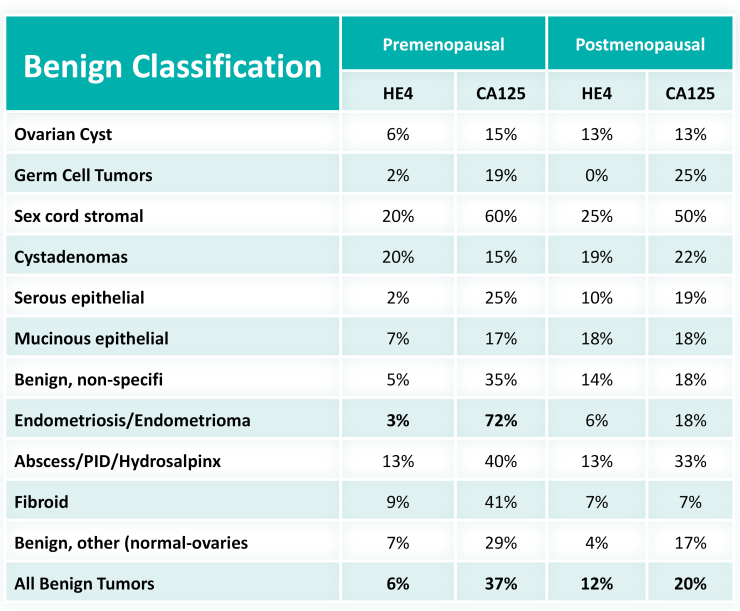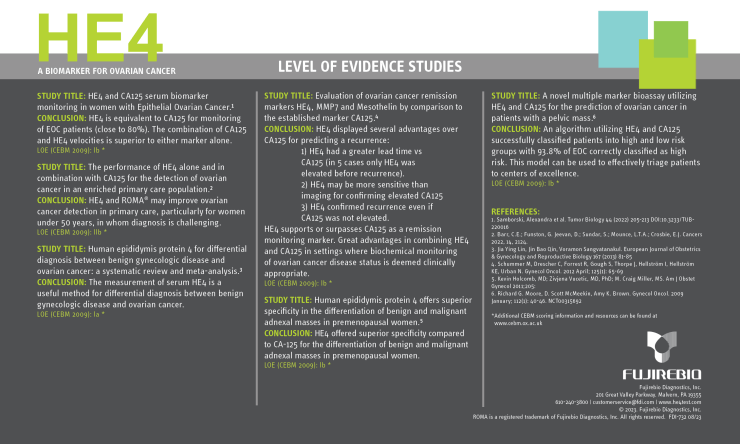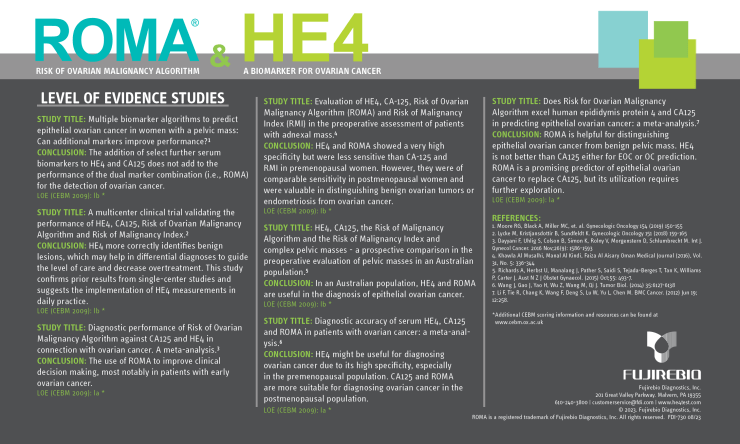
Human Epididymis Protein 4: HE4
HE4
HE4 is a serum biomarker which can be detected at high levels in patients with ovarian cancer. A combination of multiple diagnostic modalities can improve the physician’s ability to preoperatively assess women with adnexal mass. CA125 is widely used to predict malignancy in women with pelvic mass. However, it has limitations such as low sensitivity for early- stage ovarian cancers and a high rate of false positives among women with benign gynecological conditions, such as endometriosis.
Early-stage diagnosis and specialized treatment can improve clinical outcomes in ovarian cancer
- 20% of ovarian cancer patients do not express CA125 but do express HE4.1
- If a cancer patient does not have elevated CA125, multiple CT scans will be required to follow treatment response and to detect recurrent disease.
- HE4 can provide value to gynecologic oncologists when managing women diagnosed with ovarian cancer that do not express CA125 as a marker for their disease.

HE4 in Benign Gynecological Conditions
- HE4 is not increased in patients with endometriomas and other types of endometriosis, as compared to CA125.2
- HE4 is significantly higher in endometrial and ovarian cancers, but not in endometriosis.2
- CA125 is elevated in ovarian cancer and endometriosis, but not in endometrial cancer.2
- CA125 is the most commonly used biomarker for the diagnosis of ovarian cancer, but is associated with a high false positive rate among women with benign gynecological conditions.3
- HE4 has consistently been observed to be less frequently elevated in benign conditions than CA125.2,3
- In a study of 1,042 woman with pelvic mass HE4 was elevated in only 3% of premenopausal women with endometriosis, while CA125 was elevated in 72% of the same patient population.4

HE4 for Ovarian Cancer Surveillance
- HE4 was cleared by the FDA in 2008 as an aid in monitoring recurrence or progressive disease in patients with epithelial ovarian cancer.
- Measuring HE4 values during treatment may be a useful tool to monitor the response to therapy.
- Increased levels of HE4 have been shown to precede CA125 by five to eight months, thus indicating to be an important early indicator of recurring disease.
- HE4 can predict recurrence of ovarian cancer earlier than CA125 and can be elevated in patients that do not express CA125 at sufficient levels to make clinical decisions.
HE4 AND CA125 USED IN COMBINATION CAN COMPLEMENT EACH OTHER

Clinical Case Study Videos, On Demand
View our entire collection of Clinical Case Studies, presented by Dr. Richard Moore and Dr. Kevin Holcomb
Level of Evidence
The level of evidence (LOE), also known as a hierarchy of evidence, highlights the most relevant and updated scientific research in the field and can be considered the strongest form of evidence. Levels of evidence are assigned to studies based on the research design, quality of the study, and applicability to patient care. According to the Oxford Centre for Evidence-Based Medicine, there are five levels in this hierarchy of evidence: Level 1 represents strong, high-quality evidence, while Level 5 indicates evidence with effectiveness not established.7 Higher-quality evidence (Level 1) has less risk of bias. Please download and review Fujirebio's public level of evidence studies below.
HE4 Level of Evidence

HE4 & ROMA Level of Evidence

References
- Holcomb K , Vucetic Z, Miller MC, Knapp RC. Human epididymis protein 4 offers superior specificity in the differentiation of benign and malignant adnexal masses in premenopausal women. Am 1Obstet Gynecol. 2011; 205(4):358.el-6.
- Huhtinen K, Suvitie P, Hiisa J, et al. Serum HE4 concentration differentiates malignant ovarian tumours from ovarian endometriotic cysts. BR J Cancer. 2009;100:1315-1319.
- Moore RG, Miller MC ,Eklund EE, Lu KH, Bast RC Jr, Lambert-Messerlian G. Serum levels of the ovarian cancer biomarker HE4 are decreased in pregnancy and increase with age. Am J Obstet Gynecol. 2011; 206(4):349.el-7.
- Moore RG, Miller MC, Steinhoff MM, et al. Serum HE4 levels are less frequently elevated than CA125 in women with benign gynecologic disorders. Am J Obstet Gynecol. 2011;206(4):351.e1-8.
- Anastasi E, Marchei GG, Viggiani V, Gennarini G, Frati L, Reale MG. HE4: new potential early biomarker for the recurrence of ovarian cancer. Tumor Bioi 2010; 31:113-119.
- Schummer M, Drescher C, Forrest R, et al. Evaluation of ovarian cancer remission markers HE4, MMP7 and Mesothelin by comparison to the established marker CA125. Gynecol Oncol. 2011;125(1):65-9.
- OCEBM Levels of Evidence — Centre for Evidence-Based Medicine (CEBM), University of Oxford

